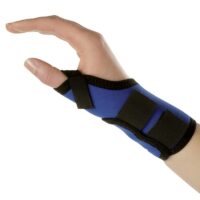Wrist Fracture
Article by John Miller

Wrist Fractures
Physiotherapy Guide to Wrist Fracture Recovery
Wrist fractures, often referred to as broken wrists, demand careful and informed management. The treatment approach varies depending on the fracture type and its stability. This guide offers insights from a physiotherapist’s perspective on managing wrist fractures effectively.
Understanding Different Types of Wrist Fractures
Wrist fractures come in various forms, including fractured radius, fractured ulna, Colles fracture, and carpal fractures like scaphoid fracture and lunate fractures. Each type requires a unique rehabilitation approach.

Managing Swelling and Pain Post-Fracture
It’s crucial to manage hand and finger swelling following a wrist fracture. Techniques such as keeping the hand elevated and regular movement, while ensuring the protection of the fracture, are vital. Being aware of complications like CRPS (Chronic Regional Pain Syndrome) is also important.
The Role of Physiotherapy in Wrist Fracture Recovery
Physiotherapy is instrumental in the recovery process. It involves exercises and the use of wrist supports, such as splints or casts. Adhering to the advice of your physiotherapist or surgeon is critical.
Enhanced Mobility and Function
Physiotherapy significantly improves mobility in the wrist joint post-fracture. Through a series of targeted exercises and manual therapies, patients can regain a range of motion, which is crucial for daily activities. This restoration of function is not just about moving the wrist but doing so without pain or stiffness.
Pain Management
One of the primary benefits of physiotherapy is effective pain management. Techniques like soft tissue massage, ultrasound therapy, and specific exercises can alleviate pain. Moreover, physiotherapists guide patients on pain management strategies that they can use at home, such as applying ice or heat.
Prevention of Long-term Complications
Physiotherapy aids in preventing long-term complications like joint stiffness, muscle weakness, or decreased function. By starting physiotherapy early in the recovery process, the risk of chronic issues is significantly reduced.
Customised Rehabilitation Programs
Each wrist fracture is unique, and physiotherapists understand this. They design customised rehabilitation programs tailored to the specific type and severity of the fracture. This personalisation ensures that the recovery process aligns with the individual’s lifestyle and physical demands.
Education and Support
Physiotherapists provide invaluable education about wrist health and injury prevention. They empower patients with knowledge about their condition and the recovery process. This support extends beyond physical treatment, offering psychological benefits as patients feel more in control and informed about their healing journey.
Improved Strength and Stability
Strengthening exercises are a cornerstone of physiotherapy. These exercises are designed to rebuild strength in the wrist and surrounding muscles, which is crucial for stability and injury prevention in the future.
Enhanced Quality of Life
Ultimately, the goal of physiotherapy is to enhance the patient’s quality of life. By restoring function, managing pain, and preventing further complications, patients can return to their normal activities and enjoy a more active, fulfilling lifestyle. This holistic approach to recovery is what sets physiotherapy apart as a vital component of treating wrist fractures.
Exercises for Wrist Fracture Rehabilitation
Exercise regimens should be tailored to the specific type of wrist fracture. Performing exercises frequently in short sessions is more beneficial than fewer long sessions.
When to Seek Professional Advice
If symptoms like increased swelling, pain, or sensations such as pins and needles occur, contacting your physiotherapist or doctor immediately is crucial. This is especially important after a traumatic fall.
Conclusion
Wrist fractures are complex injuries that require specialised care. Following the guidance of healthcare professionals ensures a safer and more effective recovery.
What to Do?
For personalised advice and treatment plans, consulting with a physiotherapist is recommended. Visit PhysioWorks for more information and resources.
Rochedale - Call 38410277
Book Online: RochedaleSalisbury - Call 32751044
Book Online: SalisburySandgate - Call 32691122
Book Online: SandgateRelated Articles
- Post-Fracture Physiotherapy: Explores the importance of tailored physiotherapy programs post-fracture, highlighting exercises and strategies for a balanced recovery.
- Effective Hand & Wrist Pain Treatment With Physiotherapy: Offers comprehensive treatment options for hand and wrist pain, including ergonomics and physiotherapy modalities like joint mobilisation and muscle treatment.
- Carpal Tunnel Syndrome: Effective Treatments: Discusses physiotherapy treatments for Carpal Tunnel Syndrome, a condition that can affect wrist health, focusing on mobility exercises and pain relief methods.
- Repetitive Strain Injury (RSI): Discussing and managing RSI, which could be helpful for preventing conditions related to wrist fractures.
- Common Causes of Wrist & Hand Pain: Let’s talk about your hand and wrist.
- de Quervain’s Tenosynovitis: Causes, physiotherapy and care.
- Wrist Tendinopathy: An article about this common forearm problem and how to fix it.




















































